 The QNAP TS-1685 is a 16-bay NAS with a somewhat unconventional configuration. The desktop form factor houses twelve 3.5″ bays designed for hard drives and four 2.5″ bays for SSDs. Better yet, QNAP has included six M.2 bays internally, which means users can load six more SATA SSDs should they like. Powering the TS-1685 is an Intel Xeon D Processor and support for up to 128GB in RAM. Turning to connectivity, the NAS has four GbE and two 10GbE ports on board. There are also three PCIe expansion slots that enable further connectivity options or add-on cards like more SSDs, graphics cards, audio cards and the like. Given all this flexibility and the myriad storage options, it’s hard to pin down exactly the best place for the TS-1685. QNAP sees it as a great option for SMBs that need a combination of file shares, virtualized storage, backup targets, and application storage — essentially making it a “jack-of-all-trades” for a growing small business or ROBO location.
The QNAP TS-1685 is a 16-bay NAS with a somewhat unconventional configuration. The desktop form factor houses twelve 3.5″ bays designed for hard drives and four 2.5″ bays for SSDs. Better yet, QNAP has included six M.2 bays internally, which means users can load six more SATA SSDs should they like. Powering the TS-1685 is an Intel Xeon D Processor and support for up to 128GB in RAM. Turning to connectivity, the NAS has four GbE and two 10GbE ports on board. There are also three PCIe expansion slots that enable further connectivity options or add-on cards like more SSDs, graphics cards, audio cards and the like. Given all this flexibility and the myriad storage options, it’s hard to pin down exactly the best place for the TS-1685. QNAP sees it as a great option for SMBs that need a combination of file shares, virtualized storage, backup targets, and application storage — essentially making it a “jack-of-all-trades” for a growing small business or ROBO location.
The QNAP TS-1685 is a 16-bay NAS with a somewhat unconventional configuration. The desktop form factor houses twelve 3.5″ bays designed for hard drives and four 2.5″ bays for SSDs. Better yet, QNAP has included six M.2 bays internally, which means users can load six more SATA SSDs should they like. Powering the TS-1685 is an Intel Xeon D Processor and support for up to 128GB in RAM. Turning to connectivity, the NAS has four GbE and two 10GbE ports on board. There are also three PCIe expansion slots that enable further connectivity options or add-on cards like more SSDs, graphics cards, audio cards and the like. Given all this flexibility and the myriad storage options, it’s hard to pin down exactly the best place for the TS-1685. QNAP sees it as a great option for SMBs that need a combination of file shares, virtualized storage, backup targets, and application storage — essentially making it a “jack-of-all-trades” for a growing small business or ROBO location.
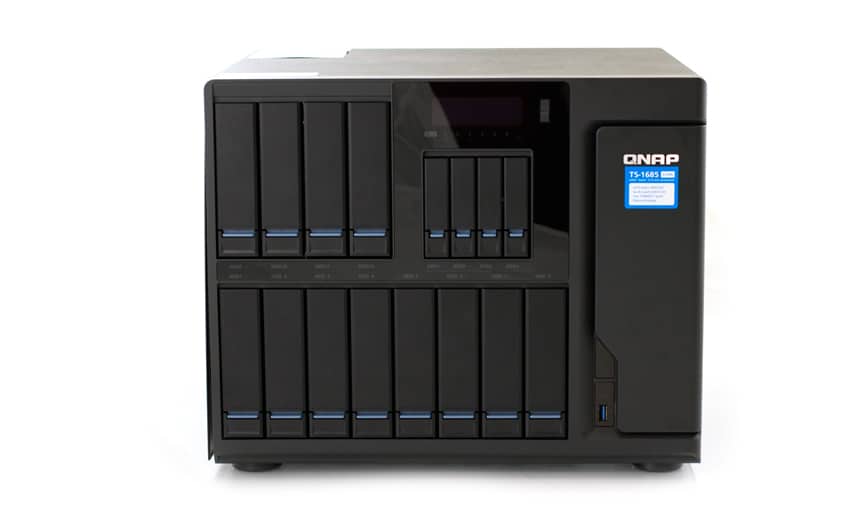
The QNAP TS-1685 has enough bells and whistles to place it in between a medium-sized business and light enterprise. The NAS comes with plenty of bays to add in some serious capacity if need be, including adding an expansion unit that brings it to a total of 56 bays. This NAS fits in well with smaller businesses that are looking to grow and may need lots of capacity and better networking down the road, but not so much that they need to invest in larger rackmount devices.
The QNAP TS-1685 is available now, starting for less than $3,000 bare with 16GB RAM. Our review unit is configured with an Intel D-1531 2.20GHz 6-core CPU and 4x16GB (64GB) RAM.
QNAP TS-1685 Specifications
- Form factor: Desktop
- CPU: Intel Xeon Processor
- Maximum memory: DDR4 128GB (with DDR4 32GB RDIMM x 4)
- Flash Memory: 512MB DOM
- Drive bays:
- 12 x 2.5″/3.5″ HDD/SSD slot
- 4 x 2.5″ SSD slot
- Supported Hard Drive: SATA 6Gb/s HDD and SSD
- M.2 Slot: 6 x M.2 2242/2260/2280/22110 SATA 6Gb/s SSD
- Ports:
- LAN Port: 2 x 10GBASE-T ports, 4 x Gigabit ports
- USB
- Front: 1 x USB 3.0 port
- Rear: 2 x USB 3.0 port
- Audio Output: 1 x built-in speaker, 1 x 3.5mm Line-out jack
- PCIe Slot
- Slot 1: PCIe Gen.3 x8
- Slot 2: PCIe Gen.2 x4
- Slot 3: PCIe Gen.3 x8
- Power
- Supply: 100-240V~, 3-1.5A, 60-50Hz, 250W PSU
- Consumption:
- Sleep mode: 61.36W
- In Operation: 127W
- Fan: 3 x 9.2cm fan (12V DC)
- Environmental
- Temperature: 0-40˚C
- Relative Humidity: 5~95% non-condensing
- Physical
- Dimensions (HxWxD): 11.96 x 14.56 x 12.59 inch (303.84 x 369.89 x 319.8 mm)
- Weight: 13.39 kg/ 29.52 lb
Design and Build
The TS-1685 uses a desktop form factor, though it is twice as tall as most NAS devices due to having so many bays. There are two rows of bays along the front: eight 3.5” bays along the bottom and four 2.5” and four 3.5” bays on the top for a total of sixteen. On the right-hand side you’ll find the QNAP branding, a power button, and a USB 3.0 port. QNAP managed to put a few more drive bays in internally. Users can easily take the cover off and remove the internal fans to get access to the six M.2 connections for even more capacity.
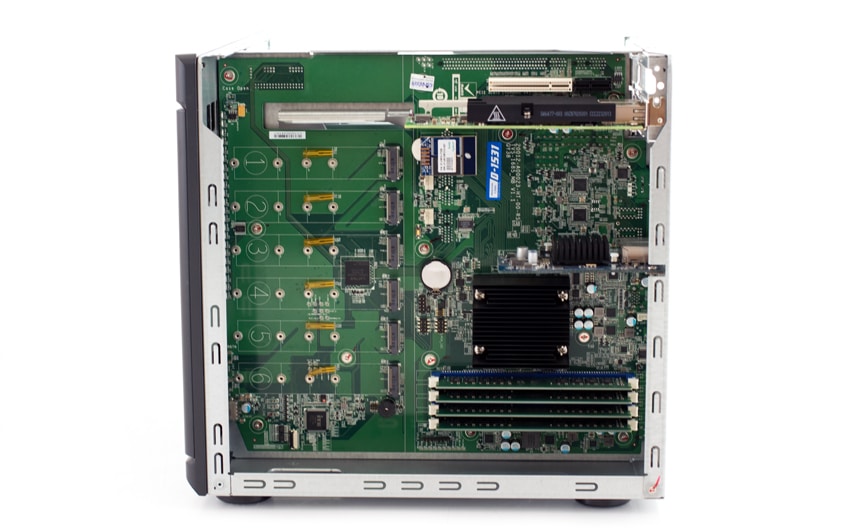
Going around to the rear of the device, one sees three large fans taking up most of the backside. Near the bottom right are the power supply and its fan. Over on the left-hand side are the four network ports, two USB 3.0 ports, and ventilation. Above that are the three PCIe slots.
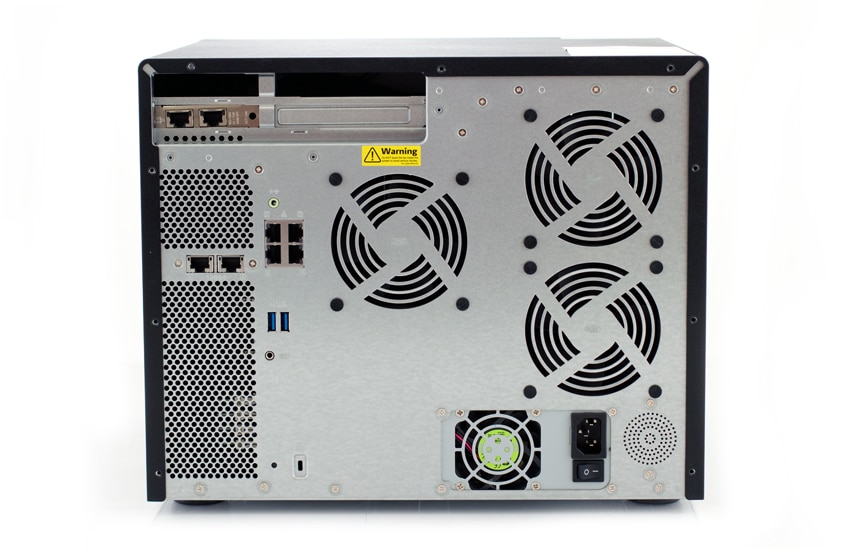
Management
Like most of QNAP’s product line, the TS-1685 uses QTS for its operating system. Going over the entirety of QTS is beyond the scope of this review. However, there are a few features in QTS that make it appealing for a NAS with this much storage. Through Storage Manager, users can see which bays are populated, as well as things like free space, LUNs, and volumes.
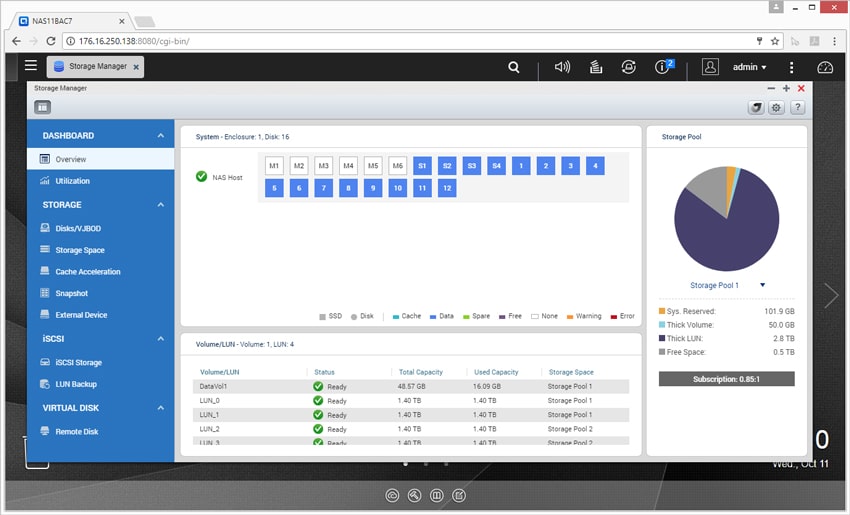
Users are able to drill down a bit deeper into storage spaces to check pools and LUNs, as well as the amount of capacity they use.
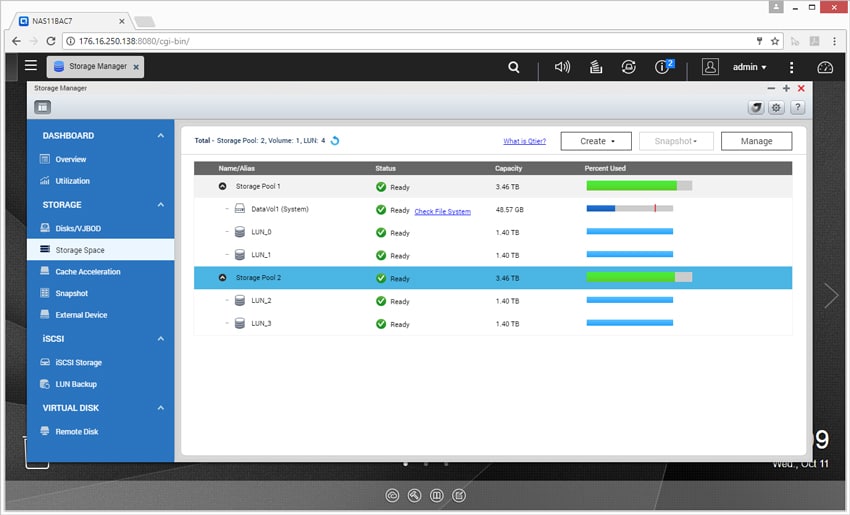
And the AppCenter allows for users to download numerous other useful Apps for business.

Application Workload Analysis
The application workload benchmarks for the QNAP TS-1685 consist of the MySQL OLTP performance via SysBench and Microsoft SQL Server OLTP performance with a simulated TPC-C workload. In each scenario, the NAS is leveraging two LUNs served from each of the two disk groups configured with 8 SSDs each. Four LUNs total were leveraged, balanced across two RAID groups. All testing was performed over dual 10Gbase-T connections attached to four ESXi 6.5 hosts.
We tested with RAID6 and RAID10 configurations in this review, focusing more on RAID10 that offered higher performance. In total, we leveraged sixteen Toshiba 960GB HK3R2 SSDs, split into two groups of 8 SSDs.
SQL Server Performance
Each SQL Server VM is configured with two vDisks: 100GB volume for boot and a 500GB volume for the database and log files. From a system resource perspective, we configured each VM with 16 vCPUs, 64GB of DRAM and leveraged the LSI Logic SAS SCSI controller. While our Sysbench workloads tested previously saturated the platform in both storage I/O and capacity, the SQL test is looking for latency performance.
This test uses SQL Server 2014 running on Windows Server 2012 R2 guest VMs, and is stressed by Quest’s Benchmark Factory for Databases. While our traditional usage of this benchmark has been to test large 3,000-scale databases on local or shared storage, in this iteration we focus on spreading out four 1,500-scale databases evenly across the QNAP TS-1685 (two VMs per disk group).
SQL Server Testing Configuration (per VM)
- Windows Server 2012 R2
- Storage Footprint: 600GB allocated, 500GB used
- SQL Server 2014
- Database Size: 1,500 scale
- Virtual Client Load: 15,000
- RAM Buffer: 48GB
- Test Length: 3 hours
- 2.5 hours preconditioning
- 30 minutes sample period
SQL Server OLTP Benchmark Factory LoadGen Equipment
- Dell PowerEdge R730 Virtualized SQL 4-node Cluster
- Eight Intel E5-2690 v3 CPUs for 249GHz in cluster (Two per node, 2.6GHz, 12-cores, 30MB Cache)
- 1TB RAM (256GB per node, 16GB x 16 DDR4, 128GB per CPU)
- 4 x Emulex 16GB dual-port FC HBA
- 4 x Emulex 10GbE dual-port NIC
- VMware ESXi vSphere 6.5 / Enterprise Plus 8-CPU
In our SQL Server benchmark, we looked at transactional performance of the QNAP TS-1685. Here, the NAS recorded 11,999.5 TPS with individual VMs ranging from 2,923.8 TPS to 3,104.6 TPS in a RAID10 configuration. In RAID 6, the QNAP device hit 11,199.2 TPS with a VM range of 2,755.9 TPS through 2,853.6 TPS.
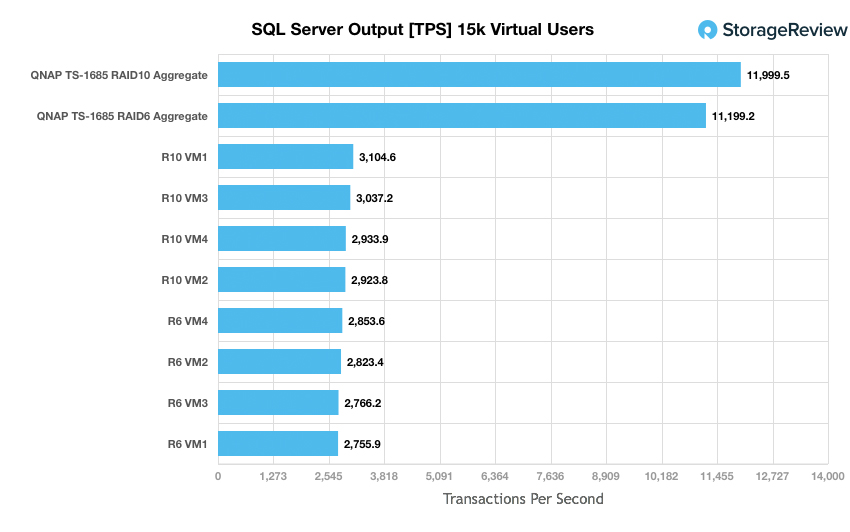
When looking at average latency, the TS-1685 recorded an aggregate of 261.5ms in RAID10 while hitting 617.5ms in RAID6. Individual VM latency ranged from 89.0ms to 389.0ms (RAID 10) and 515.0ms to 702.0ms (RAID6).
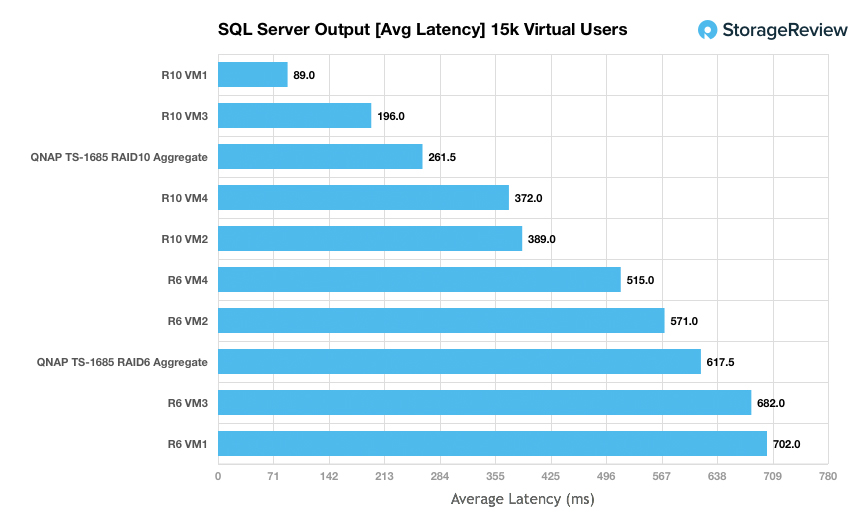
Sysbench Performance
Each Sysbench VM is configured with three vDisks: one for boot (~92GB), one with the pre-built database (~447GB), and the third for the database under test (270GB). From a system resource perspective, we configured each VM with 16 vCPUs, 60GB of DRAM and leveraged the LSI Logic SAS SCSI controller. Load gen systems are Dell R730 servers; we used four servers total.
Dell PowerEdge R730 Virtualized MySQL 4-5 node Cluster
- 8 Intel E5-2690 v3 CPUs for 249GHz in cluster (Two per node, 2.6GHz, 12-cores, 30MB Cache)
- 1TB RAM (256GB per node, 16GB x 16 DDR4, 128GB per CPU)
- 4 x Emulex 16GB dual-port FC HBA
- 4 x Emulex 10GbE dual-port NIC
- VMware ESXi vSphere 6.5 / Enterprise Plus 8-CPU
Sysbench Testing Configuration (per VM)
- CentOS 6.3 64-bit
- Storage Footprint: 1TB, 800GB used
- Percona XtraDB 5.5.30-rel30.1
- Database Tables: 100
- Database Size: 10,000,000
- Database Threads: 32
- RAM Buffer: 24GB
- Test Length: 3 hours
- 2 hours preconditioning 32 threads
- 1 hour 32 threads
For Sysbench, we tested the QNAP TS-1685 using two sets of VMs (8 and 4). In throughput, the QNAP device was able to reach 7,281 TPS and 5,208 TPS, respectively.
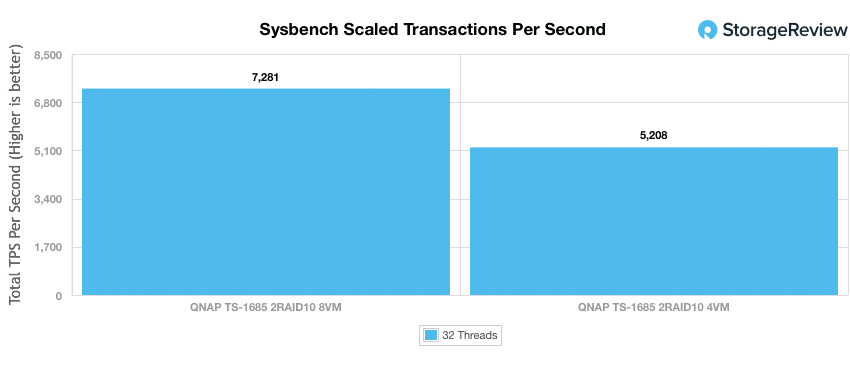
Looking at average latency, the TS-1685 recorded 24.6ms with 4 VMs and 35.4ms with 8 VMs.
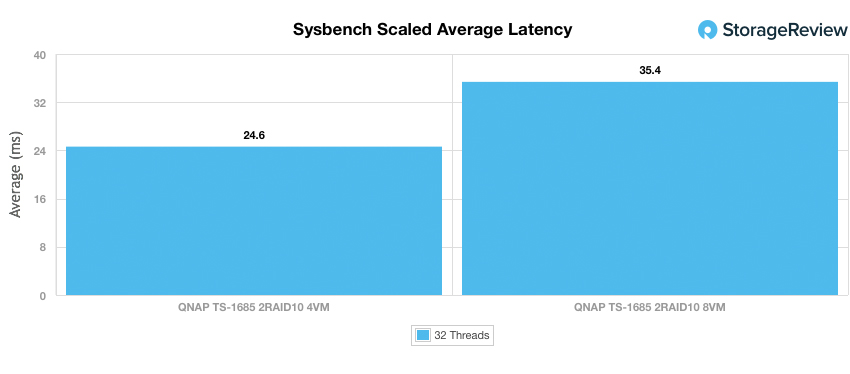
In our worst-case scenario latency benchmark, TS-1685 hit an average latency of 169.4ms and 303.6ms.
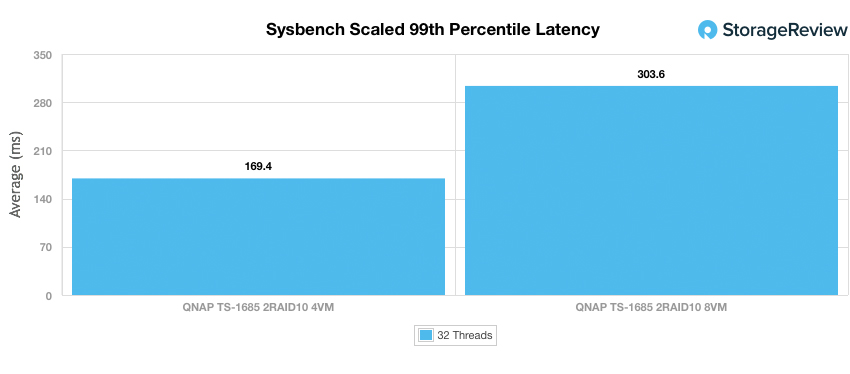
VDBench Workload Analysis
When it comes to benchmarking storage arrays, application testing is best, and synthetic testing comes in second place. While not a perfect representation of actual workloads, synthetic tests do help to baseline storage devices with a repeatability factor that makes it easy to do apples-to-apples comparison between competing solutions. These workloads offer a range of different testing profiles ranging from “four corners” tests, common database transfer size tests, as well as trace captures from different VDI environments. All of these tests leverage the common vdBench workload generator, with a scripting engine to automate and capture results over a large compute testing cluster. This allows us to repeat the same workloads across a wide range of storage devices, including flash arrays and individual storage devices. On the array side, we use our cluster of Dell PowerEdge R730 servers:
Profiles:
- 4k Random Read: 100% Read, 128 threads, 0-120% iorate
- 4k Random Write: 100% Write, 64 threads, 0-120% iorate
- 64k Sequential Read: 100% Read, 16 threads, 0-120% iorate
- 64k Sequential Write: 100% Write, 8 threads, 0-120% iorate
- Synthetic Database: SQL and Oracle
- VDI Full Clone and Linked Clone Traces
Looking at peak-read performance, the TS-1685 had an impressive low latency during 4k read performance, measuring 0.43ms at the start, and staying below 1ms under roughly 211,000 IOPS. Its peak latency was just over 13ms at 211,000 IOPS.
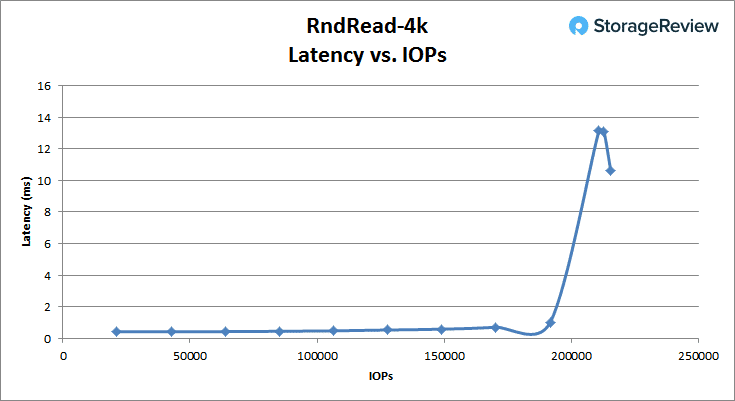
The TS-1685 continued to post solid numbers when looking at 4k peak write performance. Here, the QNAP NAS started off with a latency of 0.16ms and stayed below 1ms reaching 132,000 IOPS. At its peak, the TS-1685 recorded over 134,000 IOPS at 10.3ms.
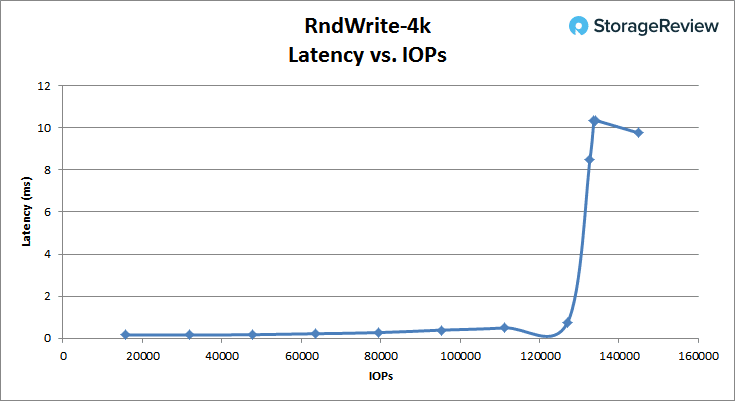
Switching to 64k peak read, the TS-1685 initially had a 0.32ms latency and stayed below 1ms until it hit roughly 29,000 IOPS. It peaked just over 34,100 IOPS with 12ms of latency. The TS-1685 finished the test with a bandwidth of 2.14GB/s.
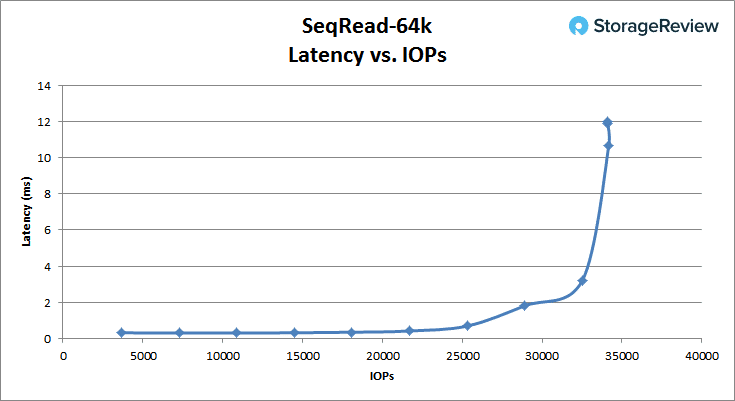
Looking at 64k sequential peak write, the TS-1685 began at 0.34ms and stayed below 1ms until it reached just over 15,700 IOPS. The TS-1685 had roughly the same throughput with a latency of just over 16ms. The TS-1685 also had a bandwidth of 986MB/s at its peak.
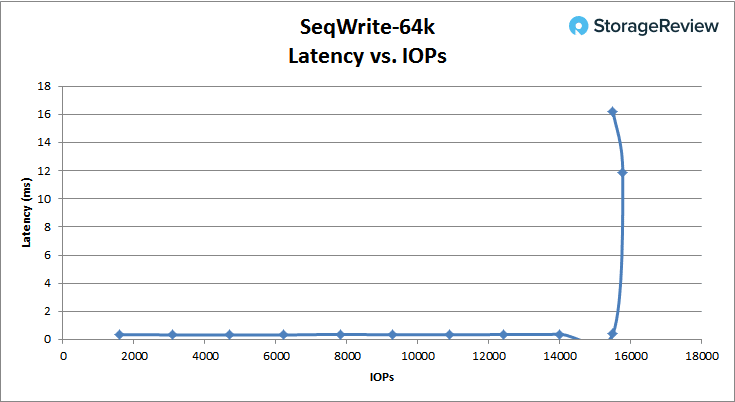
Moving on to our SQL workload, the TS-1685 began the test at 0.468ms and stayed under 1ms until just over 144,400 IOPS. It peaked at 180,000 IOPS and 4.3ms.
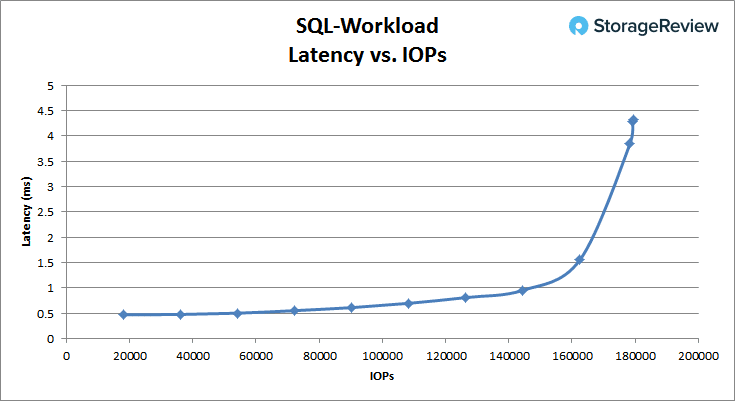
In the SQL 90-10 benchmark, the TS-1685 had an initial latency of 0.458ms and stayed under 1ms until it reached 888,425 IOPS. The TS-1685 peaked at just under 180,000 IOPS with 4.8ms latency.
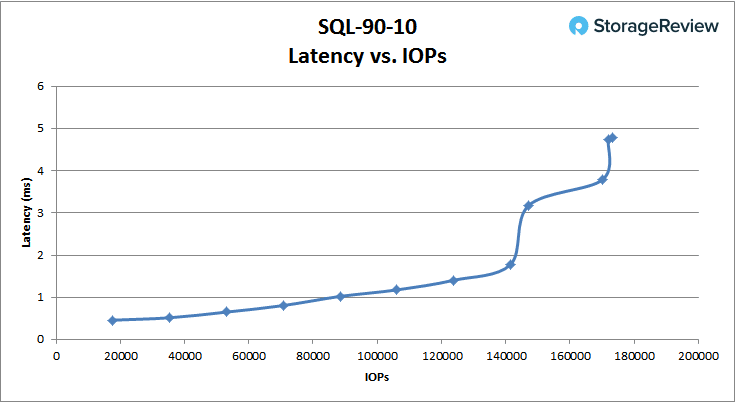
The SQL 80-20 saw the TS-1685 start with a latency of 0.47ms and stay under 1ms until it moved over 66,000 IOPS. The TS-1685 peaked at 158,000 IOPS with 5.33ms latency.
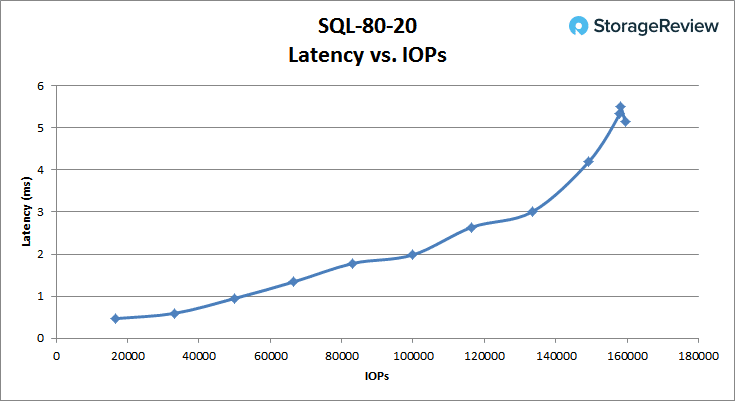
Moving on to the Oracle Workload, the TS-1685 started with a latency of 0.52ms and stayed under 1ms until it went over 45,000 IOPS. The A200 peaked at 142,000 IOPS with a latency of 7.9ms.
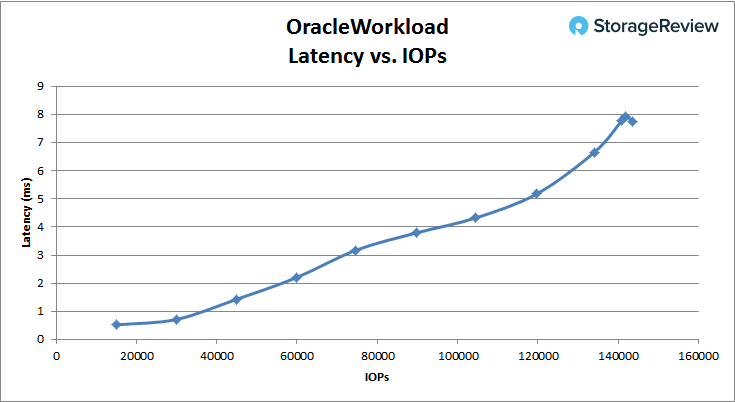
With the Oracle 90-10, the TS-1685 started off at a latency of 0.47ms and remained under 1ms until it hit 103,000 IOPS. It peaked at 171,000 IOPS with a latency of 3.29ms.
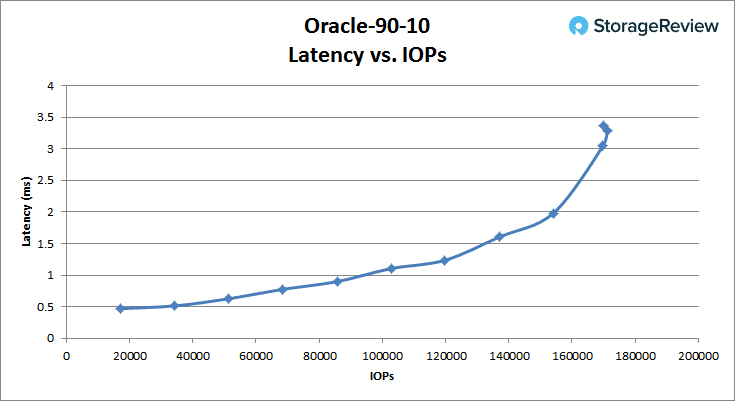
Looking at Oracle 80-20, the TS-1685 started off at a latency of 0.468ms and stayed under 1ms until it was just under 65,600 IOPS. It peaked at 159,000 IOPS with a latency of 3.61ms.
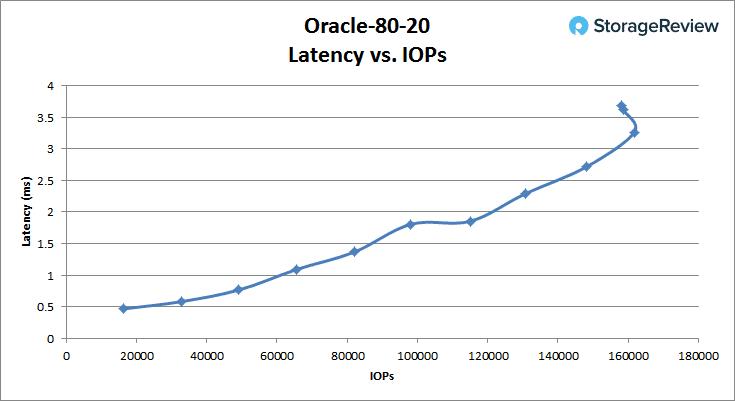
Switching over to VDI Full Clone, the boot test showed the TS-1685 to have a starting latency of 0.4ms, and stayed under 1ms until it went over 57K IOPS. The TS-1685 peaked at 138,934 IOPS with 6.9ms of latency.
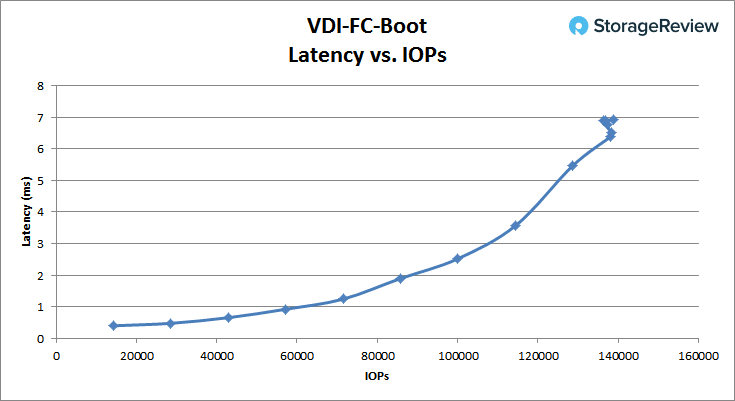
The VDI Full Clone initial login started off at 0.86ms, however, it quickly went over 1ms once it passed 4,000 IOPS. Peak performance was 42,627 IOPS at a latency of 19.9ms.
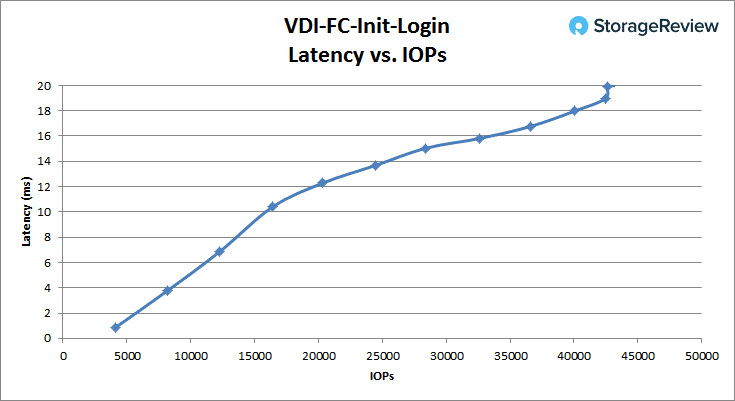
The VDI Full Clone Monday login was the first non-sub-millisecond performance, starting off above 1ms latency, 1.34ms. Peak performance was 49,982 IOPS at 10.16ms latency.
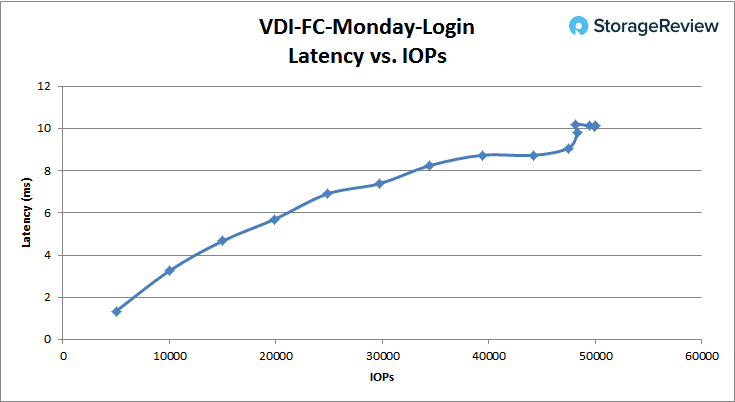
Moving over to VDI Linked Clone, the boot test showed performance staying under 1ms up to roughly 51K IOPS. The TS-1685 peaked at 81,438 IOPS at a latency of 5.6ms.
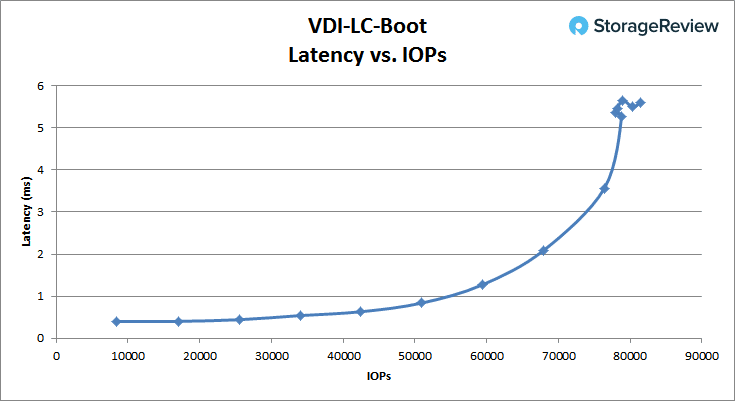
In the Linked Clone VDI profile measuring Initial Login performance, latency started off just under 1ms at 0.97ms and 3,200 IOPS. It peaked at 32,649 IOPS with a latency of 7.66ms.
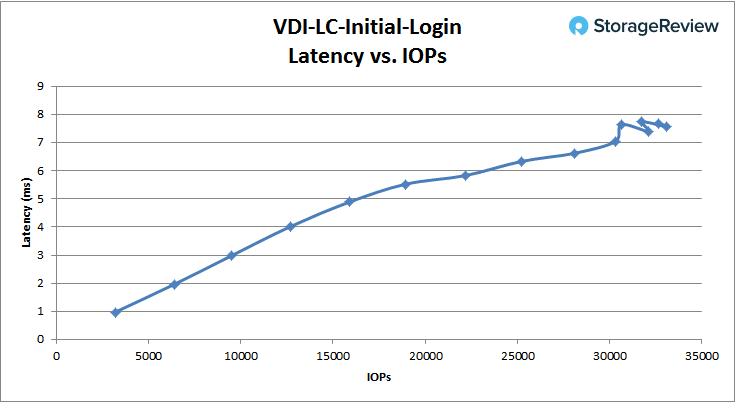
In our last profile looking at VDI Linked Clone Monday Login performance, there was no sub-millisecond latency as it started at 1.31ms with an IOPS of 3,294. It peaked at 32,359 IOPS with a latency of 15.6ms.
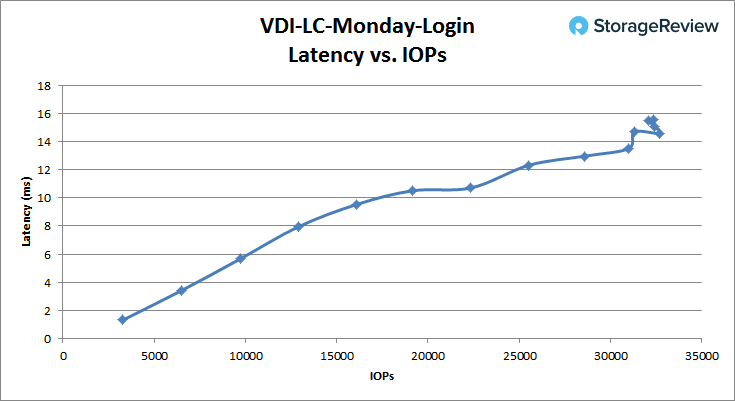
Conclusion
The QNAP TS-1685 is a desktop NAS packing more performance, capacity, and networking capabilities than is normally thought of in a midsize NAS. For starters, the NAS can house up to 16 drives (twelve 3.5” and four 2.5” or all 16 can be 2.5” drives). That can add up to a lot of storage for such a small footprint. But here QNAP outdoes itself by adding six more M.2 bays internally; not as easy to get to but potentially up to 6TB more flash capacity. From a performance perspective, the NAS comes with an Intel Xeon D Processor and supports up to 128GB in RAM. On the network side of things, the NAS has four GbE and two 10GBASE-T ports. If users need more storage capacity or 40GbE connectivity, the NAS has four PCIe slots for expansion.
Looking at performance, we ran application workload analysis benchmarks, as well as VDBench workload analysis on the QNAP TS-1685. With our application workloads, we test the NAS in both RAID6 and RAID10 configuration. In our SQL Server benchmark, we saw the TS-1685 hit aggregate scores of 11,999.5 TPS in RAID10 and 11,199.2 TPS in RAID6. For average latency, we saw aggregate scores of 261.5ms in RAID10 and 617.5ms in RAID6. For our Sysbench test, we ran 4VM and 8VM in RAID10. Overall better performance was seen with 8VMs, 7,281 TPS, 35.4ms average latency, and 303ms worst-case scenario latency. And with 4VM, we saw 5,208 TPS, 24.6ms average latency, and 169ms worst-case scenario latency.
Looking at VDBench tests, we saw an impressive amount of sub-millisecond latency for a desktop NAS. In our 4k random benchmarks, the QNAP TS-1685 was able to hit 211K IOPS read and 132K IOPS write before going over 1ms of latency. We saw stronger sub-millisecond latency performance in our 64k sequential benchmarks, with the NAS hitting 29K IOPS read and 15.7K IOPS write before going over 1ms of latency, with respective bandwidths of 2.14GB/s and 986MB/s. We ran three SQL workloads at 100% read, 90% read and 10% write, and 80% read and 20% write, with the TS-1685 hitting 144K IOPS, 888K IOPS, and 66K IOPS before hitting 1ms of latency. Running the same three tests with an Oracle workload, the NAS hit 45K IOPS, 103K IOPS, and 65K IOPS under 1ms of latency. We also ran VDI Full Clone and Linked Clone benchmarks for Boot, Initial Login, and Monday Login. With Full Clone, the TS-1685 didn’t have the stellar sub-millisecond performance of the other tests, but still showed a strong performance for a NAS with sub-millisecond performance up to 57K IOPS and 4K IOPS in boot and initial login. Linked Clone was similar, with no sub-millisecond performance in Monday Login, but performances of 51K IOPS boot and 3,200 IOPS initial login under 1ms of latency.
Pros
- Incredibly flexible for both storage and connectivity
- Strong sub-millisecond performance in VDBench, especially for a NAS in this category
- Aggressive pricing
Cons
- Redundant power supplies would be nice
Bottom Line
The QNAP TS-1685 offers SMBs/ROBOs a highly customizable NAS that supports up to sixteen drives in the front, and another half-dozen via M.2 slots inside. With further expandability via PCIe (networking, audio, video), the TS-1685 could easily take on the “jack-of-all-trades” role for numerous use cases.
Sign up for the StorageReview newsletter
